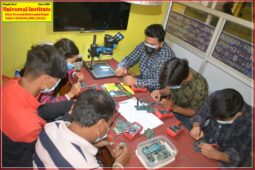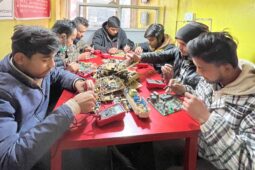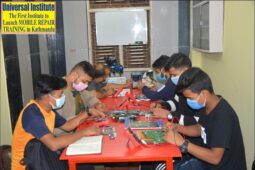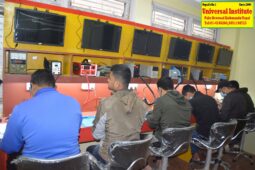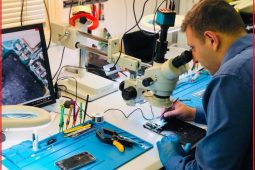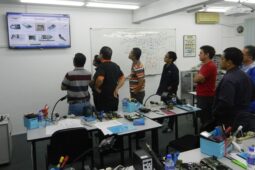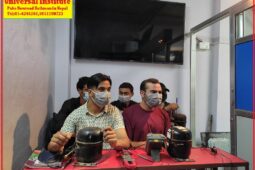Computer Hardware & Networking Course in Kathmandu
Universal Institute has always at the top when it comes to providing top quality Computer Hardware and Networking Course for more than 20 years. In order to help the students & other professionals to capitalize in this technological world, Universal offer career oriented and professional course in Computer Hardware and Networking Courses in kathmandu. We offer world-class education in Computer Hardware and our focus is to enable the students to co-relate the theory with practical. Therefore our training program is completely based on practical and gives you in-depth knowledge of understanding the Hardware and Networking of Computers.
Computers nowadays have become the integral part of our lives; it has made things really fast. Its increasing use has provided opportunity for the youngsters to start of an exciting and highly payable career in this world of IT. As if in past computer hardware and networking course was not considered as a good career opportunity but now the situation has changed, among various courses related to IT, Computer hardware and networking courses are gaining much popularity. Sales of computer desktops, laptops, printers, UPS and so on, are rapidly increasing leading to the need of hardware and networking professional in the field. Computer hardware and networking courses serves these needs.These courses not only provides high paying career in various units as hardware or networking engineer but it also increases your experience and provides a much needed exposure.You can choose from various courses offered by the institutes, which also provides certification from reputed IT companies. The basic objective of this course is to provide vast and useful knowledge about this field and give you the upper edge among the untrained professionals in this field.
About Hardware & Networking Course
This computer hardware and network ourse will mainly focus on developing the knowledge and skills. Hardware and networking training is win-win for everyone as learners can benefit from the technical skills they acquire, on the other hand, customers can find reliable and skilled Hardware expert.A computer hardware system has various integrated parts commonly known as hardware. Universal Instutute, as one of the leading IT establishments in the nation, offers a very effective and inclusive course for hardware and networking training in Nepal. This course establishes the connection between the hardware component and the learners that enables them to build a swift network. All the integrated parts work together for the proper functioning of a computer hardware system. If a computer does not work, it may be due to a problem in any one of the majer components. After you click the power button on a computer, sometimes a computer may not work either of a cable failure, lose connection of cables, power socket problems,power supply problem, RAM problems, hard disk failure, etc. We should be able to detect and resolve the computer hardware issues.
Who Can Join Hardware & Networking?
This course has been specially designed to provide fundamental concepts and then to develop the technical skills and logic required while dealing with computer hardware and network associated scenarios. Basic knowledge of IT and its operation are plus for this training. Computer Hardware and Network training is very beneficial for people who require frequent use of computers. We conduct our computer Hardware and networking training sessions in a very technological environment with sufficient training resources. Therefore, save your limited seats at the earliest to reserve your seats. Students attending this training program should have basic to advance hardware and Networking knowledge having the skill to use some basic tools.
Networking means the device physical connection of cables among the computer system and other computing devices in LAN or WAN. The networking course will develop knowledge and skills to configure the cable internet and intranet in-home or organization. Along with cable or network configuration, it will also provide knowledge of resolving all kinds of issues related to network failure and connections. Hardware and networking training at Universal Nepal helps trainees to understand basic to advance hardware and networking component which gives them a firsthand idea about hardware and networking failure.Overall, Universal offers practical knowledge on Hardware and networking under the supervision of hardware and networking experts. The objective of the course “Hardware and Network Training” is to provide in-depth knowledge of all the computer devices. An individual can independently assemble, disassemble the computer, install software, configure network devices, computers in the network, etc.The Hardware and Network Training can be listed as:
- How Computer Works; Input And Output System, Power Cabling System, Storage Systems.
- Identify And Assemble Different Parts Of Hardware Like Cpu, Ram, Motherboard, Processor, Data And Power Cables, Etc.
- Install, Uninstall Software And Troubleshoot Software Related Issues.
- Identify, Connect And Configure Different Types And Parts Of The Network.
- Diagnose and troubleshoot problems related to network adapters.
Benefits of Hardware and Networking Training
- Become qualified hardware and networking technician and trainer.
- Practical technical skills are prioritized over theoretical knowledge.
- Ability to draw a line between the cable internet and intranet.
- Creative enhancement of advance hardware and networking skills.
- Excessive career opportunities in hardware and networking job market.
- Learners can start up their own hardware and networking business…..
- Students seeking to further their knowledge in computer hardware and network.
- Job seekers looking for entering into entry-level computer hardware and networking positions.
- Students preparing for certification exams related to hardware and network like A+, CISCO
- Experienced hardware and networking professionals as instructor.
- Guaranteed internship and job placement opportunity.
- Projects are given to test the ability of the students.
Hardware & Networking Course in Nepal
Hardware and network are the pillars of growing information technology(IT) industry. Hardware and networking course deals with the tech skills to implement and manage hardware and network components. Hardware deals with physical components and networking deals with connection of system with devices. This course imparts detailed knowledge in both hardware and network areas. Hardware and Networking course establishes a practical and theoretical knowledge for pc operating a system. Students will learn to identify and make most part of hardware. They will learn to implement, understand functionality and troubleshoot the hardware and network components. They will learn to integrated electronic components. To identify the types of problems that occur in the system and solve the ones that can be solved.This course is designed for students to gain knowledge in hardware and networks. Students require to have pc basic knowledge in working in Hardware and Networking to join this course.Networking courses will enable the student to configure networks in any kind of LAN. They can resolve technical issues in networking like connectivity problems, configuration problems, etc. Moreover, students should be able to configure and run the Window Server Environment in an organization.
Hardware Course Syllabus
- Introduction
- DOS & Installing operating System
- Hardware components(Microprocessors,Memory,Motherboard,Cards)
- Disk Partition & Formatting
- Assembling PC
- Virus
- Printers, Scanners,
- Troubleshooting
Network Course Syllabus
- Introduction
- Windows
- Networking components
- Topologies
- Transfer media
- Servers & Internet
- Peer to peer n/w installation
- Networking printer installation
- Resources & Drivers
- Troubleshooting
Hardware Course in Kathmandu
Universal Training Centre has been providing this training to the students. This Computer Hardware Course requires equipment for deep understanding of the topic. Students will be able to identify and connect hardware components. Similarly, they will be taught to install and configure a hardware system. We also teach them hardware about troubleshooting and integration of components. This course opens up a door for opportunities for students. The students will get good understanding of hardware which is a huge step forward in career advancement. This will develop strong fundamental knowledge. Professionals with good command in hardware demanded in all types of companies in the world.
There is real boom in the Computer courses today including hardware course in Nepal. The requirement for the hardware engineers is increasing day by day and a great demand for the hardware engineers. Kathmandu is emerging as a top city for hardware engineers and therefore hardware courses in kathamndu is in great demand. In order to fulfill the demands of hardware engineers.Computer Hardware courses will enable the student to deal with all the aspects related to computer hardware. They can resolve any kind of technical problem in hardware like fault finding, repairing, assembling new hardware.
Syllabus of Computer Hardware Course:
1st Part: Primary & Secondary Storage Devices
- Overview to Computer Hardware
- Different Types of Devices
- Information about Processors
- Processors Cores
- RAM & ROM
- BIOS
- Hard Disks
- CD ROM
- How to Assemble PC?
2nd Part:: Understanding Motherboards
- Different Type of Motherboard
- Understanding Slots and Components of Motherboard
- Understanding the Chipset in Motherboard
3th Part: Assembling and Troubleshooting Desktops and Laptops
- Understanding the Computer Architecture, Parts and Storage Devices
- Practical Assembling of Computer and its Hardware
- Partitioning and Formatting Hard Disk
- Software and Antivirus Installation
- Understanding the Components in Laptop
- Maintenance and Assembling Laptops
- Troubleshooting & Networking Concepts
1.What is a Motherboard?
The motherboard is at the center of what makes a PC work. It houses the CPU and is a hub that all other hardware runs through. When choosing a motherboard, it’s important to check what hardware ports the motherboard supplies. It’s vital to check how many USB ports, and what grade (USB 2.0, 3.0, 3.1) they are, as well as what display ports are used (HDMI, DVI, RGB) and how many of each there are. The ports on the motherboard will also help you define what other hardware will be compatible with your computer, such as what type of RAM and graphics card you can use.
2.What is a CPU (Central Processing/Processor Unit)?
The CPU (Central Processing Unit or processor) is responsible for processing all information from programs run by your computer. The ‘clock speed or the speed at which the processor processes information, is measured in gigahertz (GHz). This means that a processor advertising a high GHz rating will likely perform faster than a similarly specified processor of the same brand and age.
3.What is RAM?
Random Access Memory, or RAM, is hardware found in the memory slots of the motherboard. The role of RAM is to temporarily store on-the-fly information created by programs and to do so in a way that makes this data immediately accessible. The tasks that require random memory could be; rendering images for graphic design, edited video or photographs, multi-tasking with multiple apps open. How much RAM you require depends on the programs that you’ll be running. Medium intensity gaming generally uses 8GB of memory when performed alongside other programs, but video/graphic design can use upwards of 16GB of RAM. Find out how much memory your computer needs.
4.What is a Hard Drive?
The hard drive is a storage device responsible for storing permanent and temporary data. This data comes in many different forms, but is essentially anything saved or installed to a computer: for example, computer programs, family photos, operating system, word-processing documents, and so on. Find out more about hard drives and how they work.
There are two different types of storage devices: the traditional hard disk drive (HDD) and the newer solid state drives (SSD). Hard disk drives work by writing binary data onto spinning magnetic disks called platters that rotate at high speeds, while a solid-state drive stores data by using static flash memory chips. Find out more about computer storage and how solid state drives work.
5.What is a Graphics Processing Unit (GPU)?
Especially important for 3D rendering, the GPU does exactly what its name suggests and processes huge batches of graphic data. You will find that your computer’s graphics card has at least one GPU. As opposed to the basic on-board graphic capabilities that PC motherboards supply, dedicated graphics cards interface with the motherboard via an expansion slot to work almost exclusively on graphic rendering. This also means you can upgrade your graphics card if you want to get a bit more performance from your PC.
6.What is a Power Supply Unit (PSU)?
A power supply unit, commonly abbreviated as PSU, does more than just supply your computer with power. It is the point where power enters your system from an external power source and is then allocated by the motherboard to individual component hardware. Not all power supplies are made equally however, and without the right wattage PSU your system will fail to work. Computer will generally need a PSU that’s rated between 350W – 850W to effectively power all hardware, although the size of the PSU will depend entirely on the power consumption of the system. Computers that are used for highly intensive tasks such as graphic design or gaming will require more powerful components and thus will need a bigger PSU to cater to this additional need.
Networking Course in Kathmandu
This comprehensive program is created to give you a complete overview of computer networking. Computer Netwoking Course is designed to provide a full overview of computer networking The classes cover everything starting from the fundamentals of modern networking technologies and protocols to an overview of the cloud to practical applications and network troubleshooting.This course covers basic to advanced topics in Computer Networking such as Software-Defined Networking (SDN), Data Center Networking and Content Distribution. Basic part is about the implementation, design principles and goals of a Computer Network and touches upon the various routing algorithms used in CN.
In this advance program, you will have the opportunity to learn advanced topics such as Software-Defined Networking (SDN), Data Center Networking and Content Distribution.
The content is divided into five parts. Learn about the implementation, design principles, various routing algorithms, resource control, and content distribution and more.
Syllabus of Computer Netwoking Course:
1st Part: Basics of Networking
- Understanding different types of Networks
- Understanding Hub and Switches
- Introduction to Topology
2nd Part: Crimping and IP Addressing
- Different IP Classes
- Understanding Octet Format
- How to Use Subnet Mask
- Understanding Ping
- Basic Commands
3rd Part: Introduction to Networking Technologies (Wired and Wireless)
- Networking Standards and Topologies
- Creating Subnets and IP Addressing
- Managing Domain, Users and Groups
- Window Server Networking
- Understanding Print Server
- How to Configure Access Points and Wireless LAN Cards
- How to Troubleshoot Networking
4th Part: Microsoft Certified Information Technology Professional (MCITP)
- How to Configure Windows Server 2008 Active Directory
- How to Configure Windows Server 2008 Infrastructure and Application Infrastructure
- How to Configure Windows 7 Client
- Designing the Windows Server 2008 Infrastructure
5th Part: Red Hat Linux
- Overview of Red Hat Linux and File System
- How to Manage Users including Linux Users, Passwords, and Changing Passwords
- How to Set Up Web Server Using Apache
- How to Install and Configure the NIS Servers and NIS Clients
- How to Configure Windows with Samba (SWAT)
- Installing and Configuring with DHCP
CompTIA A+ Training Course in Kathmandu Nepal
What is CompTIA?
The Computing Technology Industry Association (CompTIA), is a non-profit trade association, issuing professional certifications for the information technology (IT) industry. It is considered as one of the IT industry’s top trade associations. Based in Downers Grove, Illinois, CompTIA issues vendor-neutral professional certifications in over 120 countries. The organization releases over 50 industry studies annually to track industry trends and changes. Over 2.2 million people have earned CompTIA certifications since the association was established. CompTIA was created in 1982 as the Association of Better Computer Dealers.
The CompTIA A+ certification is the starting point for those who want to make IT their career. Globally recognised as the industry validation for entry-level computer technicians, this certification lays the foundation for mastery in computer and mobile hardware installation, troubleshooting, repairs and maintenance.Our interactive comprehensive training will help you prepare for the two exams that you need to pass in order to become CompTIA A+ certified — the CompTIA A+ Exam 220-801(A+ Essentials) and CompTIA A+ Exam 220-802(Practical Application). The CompTIA A+ Essentials examination measures fundamental competencies for IT professionals, while the CompTIA A+ Practical Application examination evaluates skills in practical use of current software and Operating System interface and features. Certified candidates would have demonstrated competency and knowledge in the basics of computer technology, networking, and security, and will be able to work with hardware, peripherals, networking, and security components. With this internationally recognized credential under your belt, your employers can be assured that you have the prowess required of an entry-level IT professional.
The CompTIA A+ course covers the following topics:
- Module 1:PC Components
- Module 2:Portable Computers
- Module 3:Operating Systems
- Module 4:PC Support
- Module 5:Printers and Scanners
- Module 6:Networking
- Module 7:PC Support Industry
- Module 8:Configuring and Troubleshooting the OS
- Module 9: Network Support
- Module 10: PC Maintenance and Troubleshooting
A+ Certification Course in Kathmandu
This practical “hands-on” course is the essential foundation for newcomers to PC support. It provides students with the necessary training to ensure proficiency in PC installation and troubleshooting skills. The course has been developed to produce competent PC support engineers .
A+ certification course validates the latest skills needed by today’s computer support professionals. It is an international, vendor-neutral certification recognized by major hardware and software vendors, distributors and resellers. A+ confirms a technician’s ability to perform tasks such as installation, configuration, diagnosing, preventive maintenance and basic networking. The exams also cover domains such as security, safety and environmental issues and communication and professionalism.
Related Posts:
- Mobile Repair (Advance Chip Level)
- Computer/Laptop repair (Advance Chip Level)
- Advance Mobile Software (Full)
- TV(LCD/LED/Smart) Repair Course
- Basic Electronics & PWR Supply Course 45 days
- eMMC/UFS/Nand Training 30 days
- AC & Fridge Repair Training 60 days
- Washing Machine Repair Course-30 days
- Building Electricians(House wiring) 45 days
- CCTV Camera Opearting & Installation 45 days
- Home Appliances Repair Training 45 days
- Printer Repair (Dot-Matrix, Ink-Jak, Laser)
- Hobby Electronics Projects 45 days
- Drone Assembling Course 15 days
- Laptop Repair (Basic Card Level-1)
